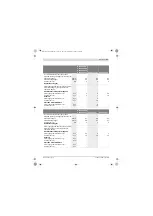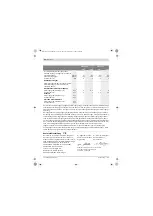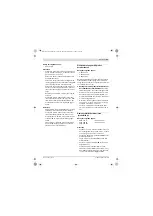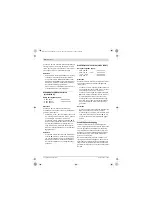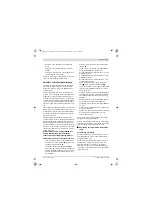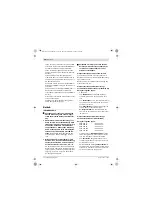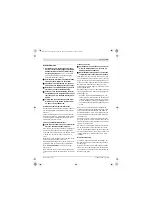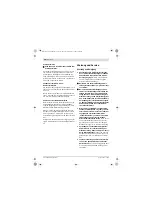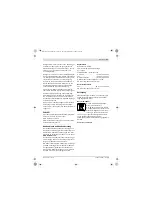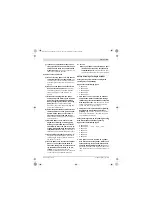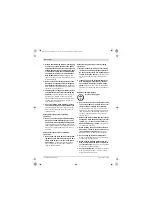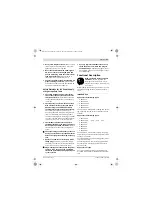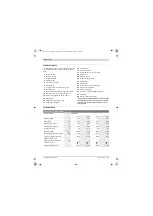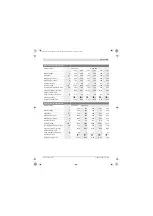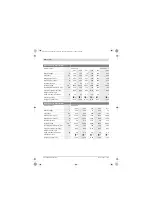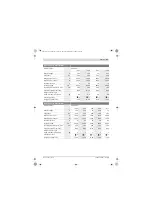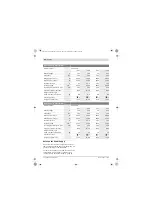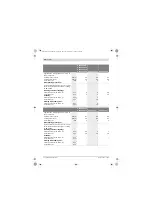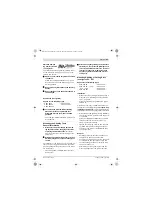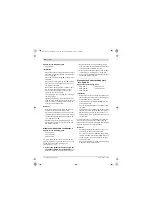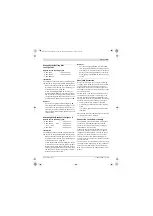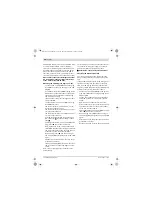
English |
35
Bosch Power Tools
3 609 929 B88 | (9/3/09)
Kickback and related warnings
f
Kickback is a sudden reaction to a pinched or
snagged rotating wheel, backing pad, brush
or any other accessory. Pinching or snagging
causes rapid stalling of the rotating accesso-
ry which in turn causes the uncontrolled
power tool to be forced in the direction op-
posite of the accessory’s rotation at the
point of the binding.
For example, if an abrasive wheel is snagged
or pinched by the workpiece, the edge of the
wheel that is entering into the pinch point
can dig into the surface of the material caus-
ing the wheel to climb out or kick out. The
wheel may either jump toward or away from
the operator, depending on direction of the
wheel’s movement at the point of pinching.
Abrasive wheels may also break under these
conditions.
Kickback is the result of power tool misuse
and/or incorrect operating procedures or
conditions and can be avoided by taking
proper precautions as given below.
f
Maintain a firm grip on the power tool and
position your body and arm to allow you to
resist kickback forces. Always use auxiliary
handle, if provided, for maximum control
over kickback or torque reaction during
start-up.
The operator can control torque re-
actions or kickback forces, if proper precau-
tions are taken.
f
Never place your hand near the rotating ac-
cessory.
Accessory may kickback over your
hand.
f
Do not position your body in the area where
power tool will move if kickback occurs.
Kickback will propel the tool in direction op-
posite to the wheel’s movement at the point
of snagging.
f
Use special care when working corners,
sharp edges, etc. Avoid bouncing and snag-
ging the accessory.
Corners, sharp edges or
bouncing have a tendency to snag the rotat-
ing accessory and cause loss of control or
kickback.
f
Do not attach a saw chain woodcarving
blade or toothed saw blade.
Such blades
create frequent kickback and loss of control
over the power tool.
Additional safety instructions for grinding and
cutting off operations
f
Use only wheel types that are recommend-
ed for your power tool and the specific
guard designed for the selected wheel.
Wheels for which the power tool was not de-
signed cannot be adequately guarded and
are unsafe.
f
The guard must be securely attached to the
power tool and positioned for maximum
safety, so the least amount of wheel is ex-
posed towards the operator.
The guard
helps to protect operator from broken wheel
fragments and accidental contact with
wheel.
f
Wheels must be used only for recommend-
ed applications. For example: do not grind
with the side of the cut-off wheel.
Abrasive
cut-off wheels are intended for peripheral
grinding; side forces applied to these wheels
may cause them to shatter.
f
Always use undamaged wheel flanges that
are of correct size and shape for your se-
lected wheel.
Proper wheel flanges support
the wheel thus reducing the possibility of
wheel breakage. Flanges for cut-off wheels
may be different from grinding wheel flanges.
f
Do not use worn down wheels from larger
power tools.
Wheels intended for larger
power tools are not suitable for the higher
speed of a smaller tool and may burst.
Additional safety warnings specific for abra-
sive cutting off operations
f
Do not “jam” the cut-off wheel or apply ex-
cessive pressure. Do not attempt to make
an excessive depth of cut.
Overstressing the
wheel increases the loading and susceptibili-
ty to twisting or binding of the wheel in the
cut and the possibility of kickback or wheel
breakage.
f
Do not position your body in line with and
behind the rotating wheel.
When the wheel,
at the point of operation, is moving away
from your body, the possible kickback may
propel the spinning wheel and the power
tool directly at you.
OBJ_BUCH-698-001.book Page 35 Thursday, September 3, 2009 12:19 PM

